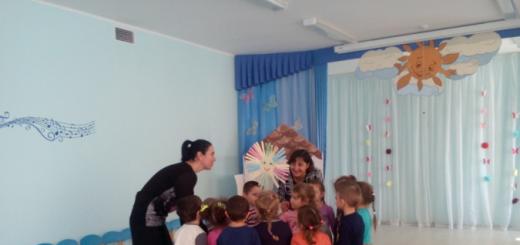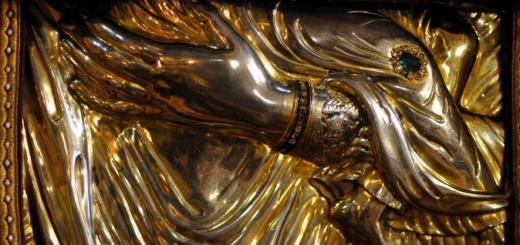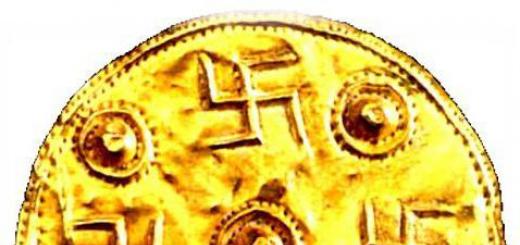Translation by A. Vasilyeva (especially for PORTAL-SLOVO.RU)
The Basilica of San Vitale, which represents a striking contrast compared to the appearance of the church of Sant'Apollinare in Classe, brings many new and original elements to Christian architecture with its plan, methods of construction, and decoration. The earlier assumptions that San Vitale originated from Hagia Sophia of Constantinople or from the Church of Saints Sergius and Bacchus seem to be completely wrong, since the latter have a later date. At the same time, a number of architectural analogies that these three temples have are quite obvious, which indicates that they belong to a single school.

A characteristic feature of temples of this type is the dome, approved on a polygonal base. We will not here explain the long evolution of this architectural form, which was born in Eastern countries and later spread to the West. One glance at the church of San Vitale is enough to understand its purely Byzantine origin. Of course, the Ravenna basilica cannot compete with the contemporary buildings of the Byzantine capital, such as Hagia Sophia, which expressed the main trends of the new architecture in a more complete, original and bold way. Nevertheless, the architectural solution of the Basilica of San Vitale is distinguished by a special skill, which is expressed in the exact miscalculation of the structures that complement it, designed to ensure the balance of the building. The high dome crowning the building is supported by eight huge pillars located on an octagonal base, connected with the outer walls of the building by powerful arches. In order to strengthen this foundation, the architect connected some pillars with others, except for the part of the building where the apse protrudes, with an ingenious system of two-story exedras with columns - a technique used later in the construction of the churches of Sts. Sergius and Bacchus and Hagia Sophia. For reasons of greater precaution, each of the outer corners of the temple has powerful buttresses. To lighten the weight of the dome, its backbone is built from long hollow pipes made of baked clay pushed into each other. Thus, performing the function of linking all parts of the building, the dome at the same time gives the appearance of the temple a kind of picturesqueness. One can only admire the ability of the architect, who so organically connected the octagonal base of the drum with the rounded shape of the dome, the skill with which he arranged the high choirs and the apse on the eastern side of the octogon, and the elegant execution of the two-story narthex located in the western part of the building, flanked by two turrets leading to the gynaecium. . After recent work to free the building from unnecessary layers, it became quite obvious that the main features of its appearance - an octagonal plan, a central drum and a roof that completely covers the dome - the Basilica of San Vitale has little in common with the Constantinopolitan church of Hagia Sophia.
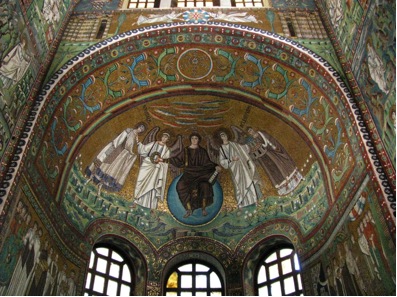
The interior of the Church of San Vitale strikes with an abundance of columns, the rows of which either meet or diverge, intersecting in the most picturesque and harmonious way. The columns are crowned with heavy stone capitals, covered with a whole interlacing of sculptural images, so thin and complex that it looks like marble lace. A whole animalistic world unfolds here - images of various birds and animals decorated with gilding. The choir fence is an openwork balustrade, carved so perfectly that it resembles some kind of precious product. The curves of the arcades are covered with partially preserved elegant marble ornaments. To get a complete impression of the interior of the basilica, it is worth looking around all its decorative decoration as a whole - the marble vestments covering the bases of the columns, their trunks painted with bright colors, sparkling mosaics that adorn the choirs and the apse. The effect of this ensemble is the beauty of the lines and the incomparable richness of color. One can only mentally imagine the former antique luxury of the building with its mosaic floor, beautiful marble wall decor, dome mosaics that do not exist now. Without a doubt, the magnificent decoration of San Vitale is the best way to get an impression of what was the Byzantine art of the VI century.
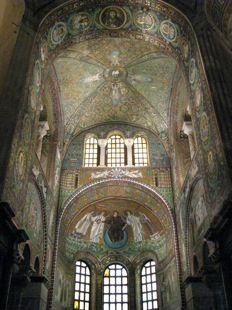
There are special places in the world where a lost era miraculously comes to life. Such are, if we talk about the same Italy, the Cathedral of St. Mark in Venice - an accurate and representative picture of the Byzantine pomp of the XI century, the lower temple in Assisi, where the mystical society of the XIV century, as if by itself, appears in the imagination of the mystical society of the XIV century, the Siena library with frescoes by Penturicio, conveying a special aroma of the outgoing 15th century. Along with these great monuments, you can also put the mosaics of the choirs of San Vitale, which can tell about the era of Justinian in the best possible way.
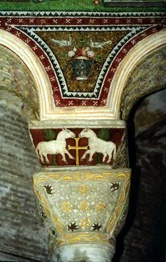
While in Hagia Sophia or in the churches of Thessaloniki the Turks painted over almost all the decorative decoration, in San Vitale the original mosaic decoration was preserved intact. From the floor to the tops of the arches - in the tympanums of the arcades, on the bends of the high windows, in the conch of the apse, the golden radiance of the mosaics attracts with the captivating harmony of rich colors. Above the entrance portal, the heads of Christ and the apostles are depicted in medallions; in the vault of the choirs, the image of the Divine Lamb flaunts, supported by four angels on outstretched arms. This image is presented on alternating gold and yellow backgrounds among an elegant branch-like ornament, in which figures of frolicking birds and animals are woven.
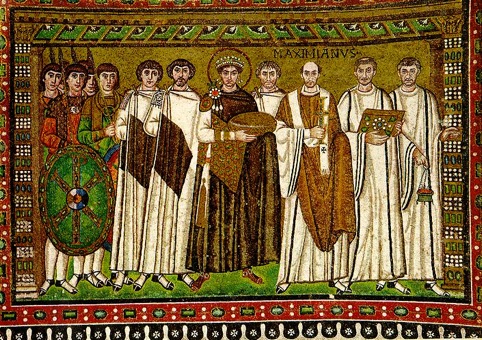
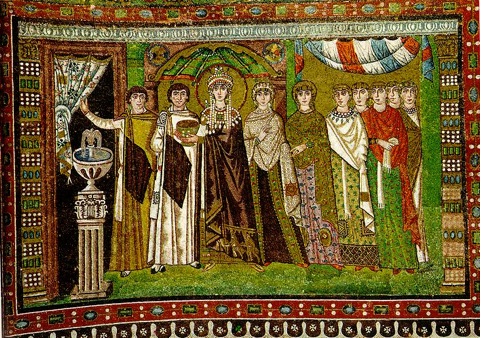
Below, on the side walls are depicted evangelists and prophets, as well as episodes from the life of Moses. Above the arcades, two large compositions represent Abel and Melchizedek presenting their gifts to the Lord, and Abraham receiving angels at the table and preparing to sacrifice Isaac. On the triumphal arch between the holy cities of Bethlehem and Jerusalem, angels are depicted in light soaring, supporting the monogram of Christ. Against the golden background of the apse is placed the image of the Savior, seated on the globe and surrounded by two angels, representing to Him St. Vitalius, the patron of the basilica, dressed in luxurious robes of the Byzantine nobility, and Bishop Ekklesios, the founder of the temple, holding in his hands covered with matter a small church, which he gives to the Lord.
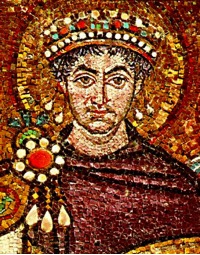


Beneath this scene, on both sides of the apse, unfold two remarkable paintings depicting Justinian and Theodora, surrounded by their court, in all the splendor of their glory. It is to these images that the eye of the viewer, entering the apse of the temple, first of all turns, so vividly are all these people here, carrying the spirit of refined luxury and perfectly mastering the skillful etiquette of the Byzantine Holy Palace. Peering into these symmetrically arranged figures, one wants to reveal the secret of the mysterious and at the same time striking with their reality faces of Justinian, the last great Roman emperor, and Theodora, this simple woman, who ascended the throne of the Caesars from behind the scenes of the hippodrome. Their mysterious figures do not cease to excite the imagination in our time.

The decorative ensemble of the Basilica of San Vitale is, without a doubt, the most complete and significant work of art left to us from the 6th century. Here everything is permeated with a single great idea, inspiring and coordinating all the main parts of the scenery. Above the altar, where the Mass was served, in the form of a lamb, the glorification of the holy bloodless Sacrifice, proclaimed by the prophets, evangelists and glorified in the images of scenes from the story of Abel, Melchizedek and Abraham, is presented.

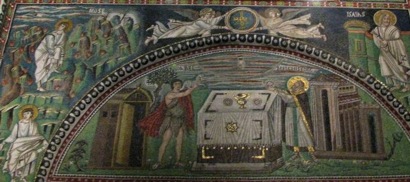
The oldest part of the decor of the Basilica of San Vitale, dating from the first decades of the 6th century, is still closely related to the works of the 5th century in its technical execution. It is known that the construction of the church was started no earlier than 526. These mosaics undoubtedly belong to the time of the construction of the temple (between 526 and 534) and thus precede the mosaics of the apse conch and two historical images of Justinian and Theodora with their retinue . As in the church of Sant'Apollinare Nuovo, a mixture of historical compositions with scenes borrowed from ancient Christian iconography is clearly manifested here. The figures of Abel, Melchizedek, Abraham, Moses are images that were often found in the art of the 3rd-4th centuries. The compositions "The Sacrifice of Abel", "Hospitality of Abraham" are distinguished by their great simplicity and ease of execution, characteristic of ancient monuments. This part of the scenery is characterized both by the beauty of ornamentation with its richness of color, which is especially evident in the decoration of the luxurious vault of choirs, and by a certain touch of realism, attention to nature, which is reflected in the manner of depicting the landscape and in the animalistic symbols of the evangelists, striking in their plausibility. In the images of the lion of St. Mark, with an open mouth and bloodshot eyes, the white bull of the Apostle Luke, with his strong physique, as well as in the images of Moses taking off his sandals, Abel, depicted in his strong and beautiful nakedness, in a lively group of Jews gesticulating in front of Aaron there is an amazing sense of the reality of life. This new quality of developing Christian art is all the more surprising in its combination with ancient traditional forms.
![]()
If in the part of the decoration just described one should note a certain sparseness of the materials used for the mosaic, then in the beautiful mosaic of the apse, on the contrary, pompous and ceremonial art manifests itself in all its splendor. Majestic and solemn figures rise against a golden background, magnificent clothes are decorated with mother-of-pearl, conveying the brilliance of pearls. An expression of grandeur is also communicated to the youthful figure of the beardless Christ, widely draped in a cloak of lilac purple. Details such as the rich costume of St. Vitaly, the characteristic, truly portrait head of Bishop Ekklesios speak of the artist's predilection for historical painting.
This courtly art quite logically finds its highest completion in the images representing Justinian and Theodora. The magnificent attire of the emperor, his officers and guards, the luxurious outfits of the empress and her retinue, sparkling with gold and precious stones, have already been repeatedly described. The luxury of the materials used to create the image - golden cubes, mother-of-pearl, precious stones perfectly matches the magnificence of the depicted palace ceremonial. It is enough to pay attention to the stone that dazzles with its sparkle, which serves to depict the buckle of Justinian's mantle, or real pearls depicting earrings in Theodora's ears. But what is most remarkable here is the individual features of the faces of the characters represented by the artist: Justinian with his wide-open eyes, long and thin nose, firm strong-willed chin, energetic and slightly preoccupied expression, Theodora with her already somewhat faded thin and melancholy face, animated big black eyes, Bishop Maximilian with his bald skull, bushy eyebrows and rather indifferent expression. Even minor characters: priests with soft smiles, rough-looking officers, shaved eunuchs with full cheeks, dazzlingly beautiful court ladies (especially the one who stands second to the right of the empress) - they all appear here as very lively and expressive portraits. Even if there is something conditional and monotonous in the most symmetrical arrangement of figures, in heavy draperies of clothes, in solemn frozen poses, all these shortcomings are redeemed by the brilliant color scheme, the splendor of the robes and the characteristic individuality of the characters. In these beautiful mosaics, which are even more saturated with oriental influences than the previous monuments of this time, Byzantine art has left us one of its most admirable creations.
To the works of the era of Justinian, we should add a number of images that have survived to our time: the image of Christ in military vestments in the archbishop's chapel, above which in the vault of the arch there are many birds frolicking against a golden background, and the mosaic decoration that once adorned the Basilica of Saint Michel in Affricisco, in many ways reminiscent of the mosaics of the Church of San Vitale. These last mosaics, acquired in 1824 by the crown prince of Prussia, are currently in Berlin and have not yet been put on display. They represent the beardless Christ standing between the archangels Michael and Gabriel. If we add to everything described two processions of saints in the church of Sant Apollinare Nuovo, then the ensemble of monuments can trace an interesting evolution of Christian art, one of the important stages of which ended during the reign of Emperor Justinian. The characteristic features of the new school are both the materials themselves preferred in this era - golden backgrounds, with mother-of-pearl and silver cubes included in them, on which luxurious ornamentation unfolds, and purely artistic features - brilliant coloring, a more majestic and solemn interpretation of human figures and, of course , the remarkable art of portraiture, which reached its zenith at this time. Here one can see a transition from simple and naive ancient Christian symbolic images, which did not suit the ceremonial nature of court art, to a more realistic manner of depiction, already characteristic of a new era. Despite an interesting attempt to return to ancient Christian symbolism in the church of Sant'Apollinare in Classe, the defeat of symbolism at this time is quite obvious. The real victory now belongs to the historical school.
© All rights reserved

